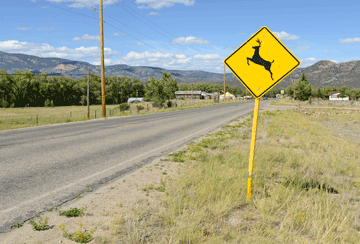
Drivers not only share the roads with cyclists and pedestrians, but wildlife too. Animals are unpredictable, and unfortunately, this means they sometimes end up under our wheels.
It's an awful feeling for most drivers, but depending on the wildlife, it can also be extremely dangerous for the driver and damaging for the vehicle. Large animals like deer, moose and bears can wreak havoc on a vehicle, sometimes to the extent that the car must be written off.
What to do when you strike an animal while driving
Here's what to do if you ever find yourself in the unfortunate situation of having hit wildlife while driving.
- If possible, pull over to a safe location. Follow the usual safety procedures such as turning on your hazard lights and remaining in your vehicle if appropriate.
- Check to make sure you and your passengers are all right. If not, the first call you make should be to 911.
- If the animal is causing a potential hazard such as blocking oncoming traffic, notify the police. Don't approach or touch the animal even if it's still alive. If this is the case, call your local Ministry of National Resources or an authorized wildlife rehabilitator to call for help for the animal.
- Then call OTIP’s 24 hour claims department at 1-866-952-2876. If it is safe, survey the damage and take photos of the damages to the vehicle and of the scene for insurance purposes. Depending on the extent of the damages, you may be required to call a tow truck. Don't fret, we can help you with this and recommend a reliable company.
Wildlife and your car insurance: is it covered?
The majority of the 10,000 annual collisions that occur with animals on Ontario's roads result in damage to the vehicle, according to data from Statistics Canada.
These types of accidents aren't covered under your mandatory minimum auto insurance coverage, but rather under the optional collisions and comprehensive coverage that can be added on to a vehicle's insurance policy. Depending on your vehicle's type and age, this is something OTIP often recommends adding to your policy in order to ensure your vehicle is sufficiently covered.
If you're not sure if you have this coverage or you would like to add it, give your OTIP broker a call at 1-866-523-4111.
Collision vs. Comprehensive
How the collision occurred will affect which part of your policy the accident is covered under.
If an animal scurried out onto the road before you struck it, for example, this would fall under comprehensive insurance as it would be considered an unforeseen peril.
If the animal was already dead and laying on the road when you struck it, this would fall under your collision insurance because you are "colliding" with something that is already there.
Prevention is your best protection
As is the case with most insurance claims, prevention is the best way to protect yourself and your vehicle against claims like this. The following tips can help you to stay vigilant:
- Exercise caution, especially in areas that are less developed and long stretches of highway, and use your high beams when appropriate.
- Slow down when driving through areas that are known to have strong wildlife presence, including near water sources and when weather conditions worsen. However, be mindful of the fact that according to wildlifecollisions.ca, it is believed more collisions with animals occur on clear nights when drivers are exercising less caution.
- Pay attention to the yellow signs that advise drivers of wildlife crossings.
- When driving at night, look for reflective yellow eyes. They're usually the first things you'll see when an animal is near.
If you have any questions about wildlife collisions, don't hesitate to give your OTIP broker a call at 1-866-523-4111. We're always happy to set your mind at ease.